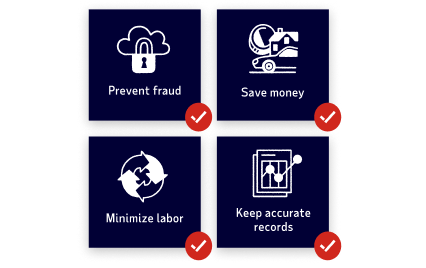FAQ
How to do payroll? | Set up for small business & LLC
Looking for an easier way to run payroll?
Key takeaways: How to do payroll independently
- Start with registrations: Apply for a free employer identification number (EIN) and any required state or local tax IDs.
- Collect new-hire documents: Gather core employee information and required documents, such as Form I-9, Form W-4,and state withholding certificates.
- Classify employees correctly: Determine exempt vs. nonexempt status following Department of Labor guidelines.
- Set up time and attendance: Have a method for accurately tracking hours worked by employees.
- Choose a pay schedule: Set compliant pay periods – weekly, biweekly, semimonthly, etc. Some states mandate specific frequencies.
- Open a dedicated payroll bank account: Pay employees and taxes using a separate account to improve security and record keeping accuracy.
Employers who are new to running a business might think they can manage payroll on their own. After all, how hard can it be to cut employee paychecks? There’s actually much more to consider, like deductions, tax remittance and reporting, and compliance management. The time required to correct inevitable mistakes is another factor. Those hours quickly stack up and drain resources that would be better spent on business growth initiatives.
Payroll can be simple, though, with the right approach. Employers have many options at their disposal, ranging from basic payroll software to full-service payroll and outsourcing. Making an educated decision begins with understanding how to do payroll.
Table of Contents
- How does payroll work?
- How to do payroll yourself in six steps
- The best payroll methods for growing businesses
- Payroll software solutions and tips to reduce payroll expenses
- How to do payroll with software in three steps
- Five common payroll mistakes and how to avoid them
- Frequently asked questions about how to do payroll processing
Although there are many steps involved in doing payroll yourself, they are not indicative of the process when working with ADP. We use automation to simplify manual labor and free up your time.
How does payroll work?
The goal of payroll is to pay employees accurately and on time while complying with all government regulations. This process encompasses the following steps:
1. Calculate hours worked and gross pay
First, the total number of hours worked by each employee must be calculated and multiplied by the individual’s pay rate.
2. Process payroll deductions and withholdings
Once gross pay has been calculated, payroll deductions must be subtracted. These include:
- Pretax deductions, such as health insurance and retirement benefits
- Federal, state and local tax withholdings
- Post-tax deductions, such as court-ordered wage garnishments or Roth IRA retirement plans
3. Calculate net pay
Net pay can be achieved by subtracting all deductions and withholdings from gross wages.
4. Distribute payment
Employees may be paid via paycheck or direct deposit. Note: some states have requirements that must be met for direct deposit.
5. File tax reports
Next, payroll tax payments and records must be filed with federal, state and local agencies.
6. Document and store payroll records
Detailed and organized records of all pertinent payroll data must be stored securely for specific lengths of time in accordance with the federal Fair Labor Standards Act (FLSA) and state laws.

Enjoy easy, online payroll processing
ADP handles automated deductions, filing, and more.
How to manually do payroll yourself
1. Apply for an Employer Identification Number (EIN)
An EIN is a lot like a Social Security Number (SSN). Just as individuals need an SSN to file their personal taxes, businesses need an EIN to file payroll taxes. Employers can easily apply for an EIN online for free by completing Form SS-4, Application for Employer Identification Number.
2. Obtain a state or local business ID
State and local governments may require a state or local tax ID separate from the federal EIN. Some states also require a state unemployment ID number to file state unemployment taxes. Employers should contact the business registration office in their state for specific details.
3. Collect employee information
The primary information employers need to gather for each employee includes:
- First and last name
- Date of birth
- Social Security Number
- Home address
- Start date
- Compensation details and information
In addition, new hires must complete the following documents:
- Form I-9, Employment Eligibility Verification
- Form W-4, Employee’s Withholding Certificate
- State withholding certificate (required in some states with income tax)
Note: If an employee does not complete a Form W-4, the employer must withhold taxes as if the employee was single or married, filing separately with no other entries.
4. Classify employees
Employees must be classified as either exempt or nonexempt. Under the FLSA, nonexempt employees are entitled to at least minimum wage and overtime pay when they work more than 40 hours in a workweek. Some states have different overtime rules for nonexempt employees.
5. Choose pay periods
Some states require specific pay frequencies for certain types of industries or circumstances. Employers should always check with their state’s department of labor before creating a payroll calendar.
6. Open a payroll bank account
Some employers opt to open a payroll bank account, separate from their business account, to pay employees and fulfill tax obligations. This practice can make it easier to keep more accurate records of payroll transactions and avoid mistakes.
Separate accounts also enhance security. For instance, if the payroll account was breached, the business finances would likely remain safe. And if the business account was compromised, the employer wouldn’t have to worry about being unable to pay the employees.
The best payroll methods for growing businesses
At some point, most small business owners outgrow their DIY payroll methods. The good news is that there are many alternatives that can help relieve them of time-consuming payroll administration. Some of these options include:
- Cloud-based technology, accessible via the internet and mobile apps, with payroll processing, tax filing and HR service capabilities
- Outsourced HR that processes payroll and administers benefits as part of a broader employee management solution
- Certified public accountants (CPA) who handle payroll and tax compliance on their client’s behalf
- Service and support models that combine custom-built payroll software with outsourced expertise
Explore ADP’s payroll solutions for small businesses
Payroll software solutions and tips to reduce payroll expenses
The primary benefit of using a payroll service is that it saves valuable time by automating labor-intensive administrative processes. It can also help employers avoid the costly penalties that often ensue from miscalculations and tax-filing mistakes.
Here are some tips to further save time and money with a payroll solution:
- Digitize paper-based tasks – Digitizing payroll processes saves costs associated with printing, storing and securing paper documents.
- Add more functions to the payroll system – Integrating payroll with time and attendance, benefits administration, and HR eliminates the need to manage separate systems and conserves resources.
- Consolidate reporting and analytics – Employers with multiple locations often appreciate cloud-based payroll software because it provides a reliable, consolidated view of payroll spend across all territories where they operate.
How to do payroll with software in three steps
Working with a payroll provider alleviates the administrative burden of payroll so employers can focus more on running their business. Getting started is easier than one might think. ADP, for instance, can onboard new clients in three easy steps:
1. Provide ADP with tax info and documentation
First, we’ll need all proper documentation and payroll records, including:
- Employee personal information
- Job information
- Company information
- Information regarding state and local regulations
- Payroll history and balances
2. Report payroll service provider authorization to the IRS
Next, employers must notify the IRS that they’ve chosen to work with ADP as their payroll service provider. Form 8655, Reporting Agent Authorization can be used for this purpose.
3. Process payroll
Employers simply enter their employee and business data into RUN Powered by ADP® and they’re ready to pay their people. They can also run a payroll and complete HR tasks anytime, anywhere with our mobile app. For additional guidance throughout the process, we offer 24/7 phone and chat support.

Five common payroll mistakes and how to avoid them
Automating payroll is the best way to help eliminate payroll mistakes. Short of that, employers can save money and headaches by avoiding these common payroll errors:
1. Misclassified worker status
Misclassifications may result in costly penalties. Employers must understand not only FLSA exemption criteria, but also the difference between employees and independent contractors.
2. Inaccurate payroll records
There are both federal and state mandates for how long payroll records must be kept. Employers should know what’s required of their business before destroying documentation.
3. Late tax payments
If using a payroll calendar, employers should track their payment dates and create tax deadline reminders to avoid late filings.
4. Misprocessed garnishments
Employers can be fined for failing to deduct garnishments or withholding them incorrectly. The court or agency issuing the garnishment will usually provide detailed withholding instructions.
5. Underreported taxable compensation
Stock options, employee discounts and other fringe benefits may be taxable. Employers should understand what constitutes imputed income and report it to the government.
Frequently asked questions about how to do payroll processing
How does a payroll system work?
A payroll system automates employee payments by calculating gross pay, deducting taxes and other withholdings, and distributing net pay via direct deposit or paycheck. It also saves payroll records and may include tax filing services and compliance support. Ultimately, payroll systems help employers save time and improve accuracy.
What is payroll?
The term payroll can mean different things to different people. Employees might think of it in terms of how often and how much they are paid. An employer, on the other hand, may see the bigger picture of the process – calculations, worker classifications, tax deductions, etc. – that goes into creating a paycheck. In reality, payroll is all of these things.
How do I start and do payroll?
To begin processing payroll, employers must gather information about their employees and their company. The required details include worker classifications, tax withholdings, Social Security numbers, business tax ID numbers and more. Employers must also determine their payroll frequency and the benefits they’ll offer, since these are usually deducted from employee wages.
What are the benefits of using a payroll system?
One of the main benefits of partnering with a payroll service provider is that it gives employers more time to focus on their business instead of burdensome administrative tasks. It can also save money because there’s less chance of miscalculations or missed tax deadlines, which can result in expensive penalties. These advantages are possible because payroll software automatically pays employees and files taxes on employers’ behalf.
How are payroll taxes calculated?
Payroll taxes are typically calculated by deducting the following from the employee’s gross pay:
- Federal income tax, based on Form W-4 details
- Social Security tax (6.2% of wages)
- Medicare tax (1.45% of wages)
- State and local taxes
What is the correct definition for manual payroll?
Manually processing payroll means cobbling together a payroll solution based on one’s own skills and experience. Spreadsheets and traditional bookkeeping methods are usually involved. Such DIY approaches may be sufficient for businesses that only employ a handful of people, but they quickly become unfeasible as the organization grows.
What payroll reports do employers need to file?
There are many employment tax forms that employers may need to file, depending on their business size and operations. Some of the more common forms include but are not limited to the following:
- Form 940, Employer's Annual Federal Unemployment (FUTA) Tax Return
- Form 941, Employer's Quarterly Federal Tax Return
- Form 944, Employer's Annual Federal Tax Return
Employers also have to furnish some annual forms to payees. Examples include Form W-2, Wage and Tax Statement and Form 1099-NEC, Nonemployee Compensation.
When should you outsource payroll?
Effective payroll management remains a challenge for many businesses. Employers may want to consider switching providers or outsourcing payroll altogether if they experience any of the following:
- Payroll is inaccurate, inefficient or difficult to complete
- The current payroll system does not take full advantage of technology
- Payroll processing demands too much precious time
- The business is penalized by the IRS for compliance violations
Want more exclusive business insights like this delivered to your inbox?Subscribe now
This guide is intended to be used as a starting point in analyzing how to do a payroll and is not a comprehensive resource of requirements. It offers practical information concerning the subject matter and is provided with the understanding that ADP is not rendering legal or tax guidance or other professional services. Please consult with your legal counsel.
1. ZipRecruiter is a registered trademark of ZipRecruiter, Inc.
2. Legal services are provided by Upnetic Legal Services, a third-party provider




